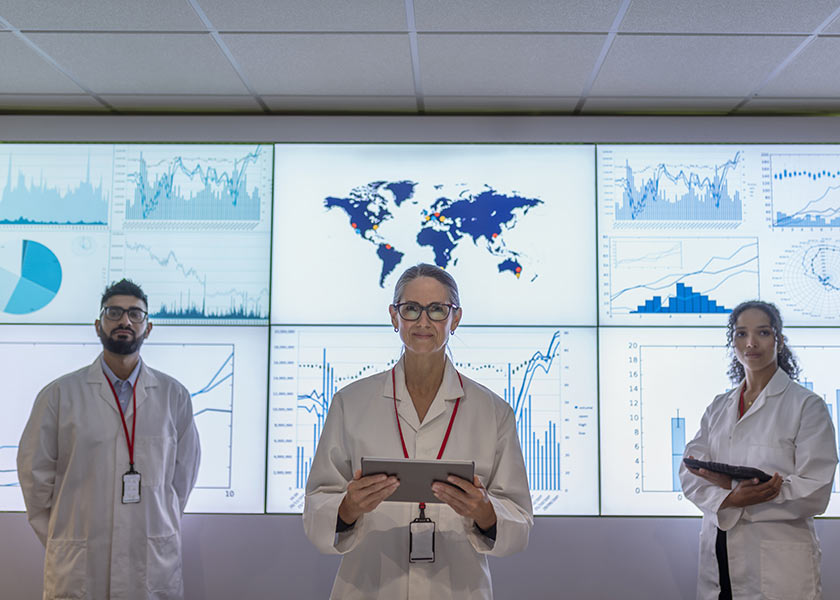
VUSN’s transformed program focuses on training nurses to be technology leaders
Story by Amy Wolf
Walk into any modern hospital room and you’ll find as much precisely calibrated equipment as in the cockpit of a 787, machines capable of monitoring and recording just about every known biological function.
It’s often nurses who utilize this ever-more sophisticated technology, drawing on real-time data to help treat patients and collaborate with the health care team in making diagnoses or charting a path for care.
But this information—the amount of which has exploded in recent years—doesn’t stop at the patient’s bedside. It’s often aggregated into a de-identified massive set of numbers that can help researchers search for large-scale patterns that could ultimately lead to new innovations and novel insights.
Nurse informaticists, health informaticists and data scientists have traditionally been the specialists helping make sense of these massive data sets. As the amount of data collected grows exponentially, it provides the ability to examine health care in entirely new ways, particularly in nursing.
In 2019, the increased opportunities and new capabilities available to informaticists led Vanderbilt School of Nursing to completely revise its nursing informatics master’s program to incorporate newly emerging informatics competencies. Graduate students study the latest techniques and tools for data analysis, detecting health patterns among large populations and exploring new developments in health technology.
“This is not a typical informatics program. We believe strongly that the valuable informatics nurses of the future are going to be those who not only facilitate the means to collect data, but also know how to analyze and interpret it,” says Brenda Kulhanek, PhD, academic director for the nursing informatics specialty, which was ranked No.3 in the nation by US News & World Report in 2019.
Kulhanek is one of the leaders brought to VUSN to elevate the specialty program. After beginning her career at the patient bedside, her interest in technology and passion for nursing led her to education and informatics leadership roles at TriStar Health, HCA Healthcare and other health systems. She advocated for nurses and the specialty as then-president of the American Nursing Informatics Association.
Valuable Partnerships
Program leaders say Vanderbilt’s trans-institutional partnerships tied to data analytics are what sets its program above others. These partners include the Department of Biomedical Informatics, the Vanderbilt Data Science Institute, Vanderbilt Clinical Informatics Center and The Wond’ry, Vanderbilt’s Innovation Center. They’ve also built external relationships, bringing in experts from tech giants such as Apple, Microsoft, Google and others.
“We have created what I believe is one of the most unique and forward-thinking programs in informatics nursing because of our robust resources inside and outside of the university,” says Patricia Sengstack, DNP’10, FAAN, FACMI, VUSN senior associate dean for informatics. She has a joint appointment as a nursing informatics consultant at Vanderbilt University Medical Center.
Sengstack is another leader transforming the informatics program. She came to Vanderbilt with a strong history of nursing informatics expertise, having led nursing informatics for 15 hospitals in the Bon Secours Health System. She also worked with the National Institutes of Health Clinical Center to develop and implement an electronic health records system for clinical research trials.
“Having the electronic health records system come to life for the NIH Clinical Center and to see the ability for doctors, nurses, social workers, physical therapists—everybody—to be able to access an electronic health record that’s comprehensive and collaborative was just revolutionary,” Sengstack says.
Eye on AI
Most recently, researchers and students in the program have begun to explore the worlds of artificial intelligence and machine learning—technology designed to vastly accelerate data analysis, or in scenarios reminiscent of sci-fi, to augment human capabilities.
“AI is able currently to use collected data to tell when a patient is getting septic or may get another infection before humans can pick it up. But there needs to be a nurse who understands the technology and data—and we’ve built that into our program, which is not common,” Kulhanek says.
The types of jobs for nursing informaticists are expanding as quickly as the field, whether in hospitals and other health care facilities to software companies and government agencies.
“The need for informatics—and professionals who understand it and use it every day in patient care—is expanding exponentially,” says Pamela Jeffries, PhD, FAAN, ANEF, FSSH, dean of the Vanderbilt School of Nursing and Valere Potter Distinguished Professor of Nursing. “Vanderbilt focuses on educating and supporting a high-caliber nurse who brings the competencies needed for the best quality patient care, and nursing informatics is the next level of that.”
Making Technology Accessible
Another goal of the informatics nurse specialty is to increase the understanding of how current health care technology can be used most effectively and accessibly by health practitioners and patients alike.
This aspect of the specialty program is something Kelly Aldrich, DNP, director of innovation and associate professor of informatics at VUSN, is passionate about teaching and implementing.
She has spent more than three decades on the front lines of health care informatics, devising numerous technologies to aid nurses and patients. In 2006, she helped create and launch a technology that allows nurses to automate the input of vital signs in a central database instead of transcribing them in multiple areas. It was revolutionary for the time and is now an industry standard in use today.
“We designed this product that created a barcoded wristband protocol for each patient, and it allowed the caregiver to send the vitals immediately to multiple sources,” Aldrich explains. “This was a game changer for nurses, giving them time to focus on their patients while providing automation of crucial health data algorithms and immediately notifying the care team of deterioration or complications with the patient.”
Three years later, in 2009, the work of Aldrich, Kulhanek, Sengstack and other nursing informatics leaders was bolstered with the passage of the federal Health Information Technology for Economic and Clinical Health (HITECH) Act. It was created to promote and expand the adoption of health information technology—focusing mainly on the use of electronic health records by health care providers.
“The valuable informatics nurses of the future are going to be those who not only facilitate the means to collect data, but also know how to analyze and interpret it.”– Brenda Kulhanek
Along with teaching in the nursing informatics specialty, Aldrich serves as the chief clinical transformation officer for the Center for Medical Interoperability, a national nonprofit working to integrate health care technologies so that they can exchange information.
“Our goal in health care informatics is to provide the right tools of technology and the best data information possible to support the clinicians and reduce burdens on them, especially when it comes to charting and data entry, so they can focus on giving personal hands-on care,” says Aldrich, who before coming to Vanderbilt was the inaugural chief nursing informatics officer for HCA Healthcare, leading informatics strategies for more than 170 hospitals.
As technology expands in the health care arena, the partnership between clinicians and outside industry to create real-time innovation and ideation is more important than ever.
“That means really listening to the nurses to find out what they need and partnering with nurse informaticists and technical experts to create devices and systems that providers will use to make health care experiences better for all sides,” Aldrich says.
COVID put informatics in the spotlight
The COVID-19 pandemic put a major spotlight on the real-life impact of health care informatics.
In 2019—before the arrival of COVID-19—Aldrich and the Center for Medical Interoperability were contracted by the Center for Disease Control and Prevention to demonstrate an automated, ledger-based system that could be used for the trusted transmission of data about personal protective equipment (PPE) from multiple supply chain systems. This would be needed for national PPE tracking in a potential pandemic; the project came from the National Personal Protective Technology Laboratory at the CDC’s National Institute for Occupational Safety & Health.
The research started with a theoretical pandemic, but in 2020 it became reality.
Hospitals were running through disposable protective gear faster than it was being shipped. Aldrich and her research partners quickly took their supply chain strain theory and started feeding it with real-time data. This alpha project phase connected 78 hospitals in nine Health and Human Services’ regions for a demonstration period of 16 weeks. It provided hundreds of thousands of real-time, automated data points for predictive modeling and other data analysis to help hospitals and the CDC examine exactly what PPE they had available so they could come up with innovative ways to keep caregivers and patients safe.
The CDC recently funded a second phase of research for Aldrich at VUSN. With this segment, Aldrich has brought in Vanderbilt Data Science Institute collaborators, Chief Data Scientist Jesse Spencer-Smith, PhD, and Vanderbilt School of Engineering Professor of the Practice Dana Zhang, MS’18, PhD’18. Together they are working with several institute graduate students to analyze information collected from participating health care organizations and develop predictive models tied to their medical inventory.
“We’re doing data analysis on a medical organization’s burn rates to figure out: Will they have enough PPE and other essential items to provide for their teams? And that’s going to be where some interesting predictive modeling comes in. I think because of that, it will have a true impact on supply chain management for the country,” Aldrich says.
Informatics nurses played other vital roles at the start of the COVID-19 pandemic, when many caregivers and patients were pushed into types of care they weren’t used to.
“Informatics nurses stepped in and quickly got organizations set up with telehealth, trained people on new remote technologies, simplified clinical documentation and even built and managed applications and dashboards to help keep track of COVID data,” Kulhanek says.
The knowledge and ability to capture and work with data is key to nursing informatics, but Vanderbilt doesn’t want to limit its study to only those MSN students in its NI specialty. Currently, VUSN’s doctor of nursing practice students are taught nursing informatics, with the possibility that all students will receive NI education in the future. That goes hand-in-hand with the school’s vision of teaching all nurses to effectively use data in their practices.
“We’re continually challenging students and decision-makers: How are we building a data culture? How are we expanding that innovation culture?” Aldrich says. “I think that’s really exciting, and I’m ready to work with these amazing students and fellow nurses to take on that challenge.”


